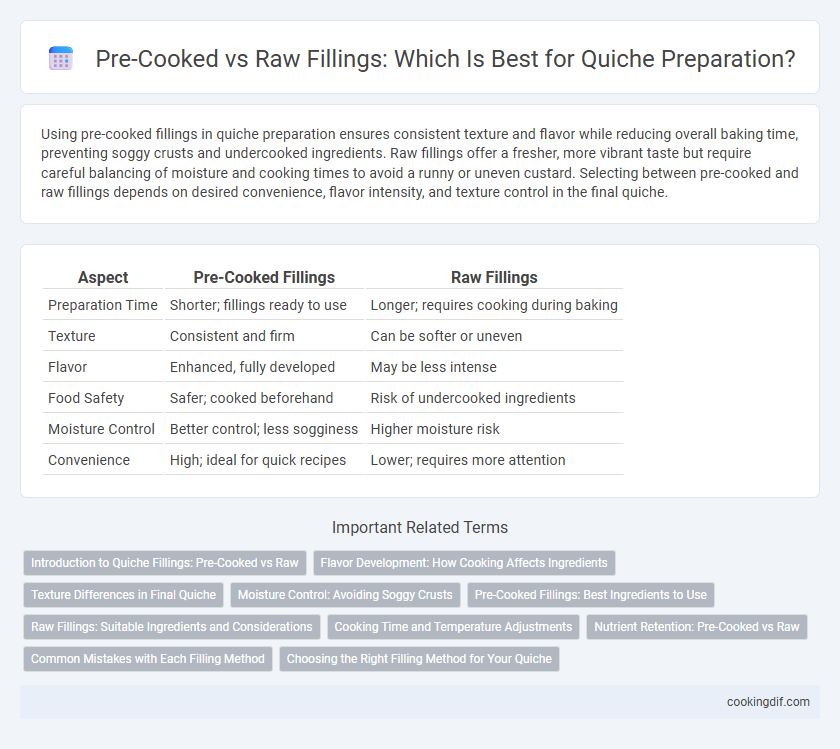Using pre-cooked fillings in quiche preparation ensures consistent texture and flavor while reducing overall baking time, preventing soggy crusts and undercooked ingredients. Raw fillings offer a fresher, more vibrant taste but require careful balancing of moisture and cooking times to avoid a runny or uneven custard. Selecting between pre-cooked and raw fillings depends on desired convenience, flavor intensity, and texture control in the final quiche.
Table of Comparison
| Aspect | Pre-Cooked Fillings | Raw Fillings |
|---|---|---|
| Preparation Time | Shorter; fillings ready to use | Longer; requires cooking during baking |
| Texture | Consistent and firm | Can be softer or uneven |
| Flavor | Enhanced, fully developed | May be less intense |
| Food Safety | Safer; cooked beforehand | Risk of undercooked ingredients |
| Moisture Control | Better control; less sogginess | Higher moisture risk |
| Convenience | High; ideal for quick recipes | Lower; requires more attention |
Introduction to Quiche Fillings: Pre-Cooked vs Raw
Pre-cooked fillings for quiche offer enhanced flavor development and precise texture control by allowing ingredients like bacon, onions, or vegetables to caramelize and soften before baking. Raw fillings, such as fresh spinach or grated cheese, save preparation time and release moisture during baking, which can result in a creamier quiche but may risk a soggy crust. Selecting between pre-cooked and raw fillings impacts the quiche's overall taste profile, moisture balance, and structural integrity.
Flavor Development: How Cooking Affects Ingredients
Pre-cooked fillings for quiche enhance flavor development by allowing ingredients like onions, mushrooms, and meats to caramelize and release deeper, more complex tastes through the Maillard reaction. In contrast, raw fillings may retain a fresher, lighter profile but often result in a less integrated flavor due to limited cooking time inside the quiche. Properly cooking fillings beforehand also reduces excess moisture, preventing a soggy crust and ensuring a balanced, rich taste experience.
Texture Differences in Final Quiche
Pre-cooked fillings in quiche result in a more consistent and firmer texture as the ingredients release less moisture during baking, preventing sogginess in the crust. Raw fillings tend to produce a softer, sometimes slightly watery texture due to the natural moisture content that cooks during baking, potentially leading to a less structured quiche. Choosing pre-cooked fillings like sauteed vegetables or fully cooked meats enhances texture control and maintains a balanced custard-to-filling ratio.
Moisture Control: Avoiding Soggy Crusts
Using pre-cooked fillings in quiche preparation significantly reduces excess moisture, preventing soggy crusts by allowing ingredients to release steam before baking. Raw fillings often release water during cooking, soaking the crust and compromising its texture. Proper moisture control is essential for achieving a crisp, flaky quiche crust that holds its shape and flavor.
Pre-Cooked Fillings: Best Ingredients to Use
Pre-cooked fillings for quiche ensure even cooking and prevent soggy crusts by reducing moisture release during baking. Ideal ingredients include sauteed mushrooms, caramelized onions, cooked bacon, spinach drained of excess water, and fully cooked chicken pieces. Using these prepared fillings enhances flavor concentration and maintains quiche structural integrity.
Raw Fillings: Suitable Ingredients and Considerations
Raw fillings for quiche preparation often include vegetables such as spinach, mushrooms, bell peppers, and onions, which release moisture during baking and enhance flavor depth. It is essential to consider the water content of raw ingredients to prevent a soggy crust, so often a quick saute or draining excess moisture is recommended before addition. Proteins like diced raw bacon or ham must be fully cooked during baking, requiring careful attention to oven temperature and time to ensure food safety and optimal texture.
Cooking Time and Temperature Adjustments
Using pre-cooked fillings in quiche preparation reduces overall cooking time and ensures even heating, allowing the quiche to bake at a standard 350degF (175degC) for 35-40 minutes until the custard is set. Raw fillings require longer baking at a slightly lower temperature, around 325degF (160degC), for 45-50 minutes to fully cook the ingredients while preventing the crust from burning. Adjusting cooking time and temperature based on filling type is essential to achieve a perfectly cooked quiche with a golden crust and a fully set, flavorful filling.
Nutrient Retention: Pre-Cooked vs Raw
Pre-cooked fillings for quiche often result in higher nutrient retention of heat-sensitive vitamins like vitamin C, as the pre-cooking process helps to rapidly lock in nutrients before baking. Raw fillings can lose more nutrients during the longer baking time, especially water-soluble vitamins, due to extended heat exposure. Using pre-cooked vegetables or meats ensures better preservation of nutritional quality, enhancing the overall health benefits of the quiche.
Common Mistakes with Each Filling Method
Using pre-cooked fillings in quiche often leads to overcooked or dry textures because residual heat further cooks the ingredients during baking. Raw fillings, on the other hand, risk releasing excess moisture, resulting in a soggy crust and uneven cooking. Balancing ingredient moisture and cooking times is crucial to avoid these common mistakes and achieve a perfectly textured quiche.
Choosing the Right Filling Method for Your Quiche
Pre-cooked fillings for quiche ensure even cooking and prevent sogginess by reducing excess moisture, enhancing texture and flavor consistency. Raw fillings may release water during baking, risking a runny or undercooked quiche, especially with vegetables like spinach or mushrooms. Selecting pre-cooked ingredients like sauteed onions or roasted meats optimizes the custard's set and elevates the overall dish quality.
pre-cooked fillings vs raw fillings for quiche preparation Infographic

 cookingdif.com
cookingdif.com